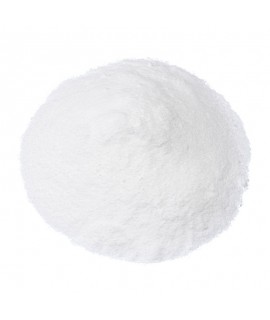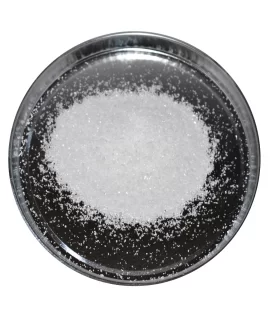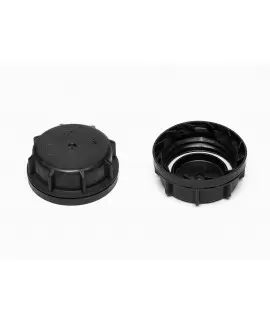DEXTROSE monohydrate 99%, food grade, kg
3.50 €
Dextrose monohydrate, CAS 77938-63-7, glucose analog, D-glucose monohydrate
Parameter | Attribute |
Dextrose | Dextrose monohydrate, glucose analogue, D-glucose monohydrate |
Formula | C6H14O7 |
Structure |
|
IUPAC | 2,3,4,5,6-pentahydroxyhexanal;hydrate |
INCI | - |
CAS | 77938-63-7 |
Molar mass | 198.17 g/mol |
Density | 1.54 g/cm3 (crystal), 0.70 g/cm3 (bulk) |
Solubility | 909 g/L 25 °C |
Dextrose is a simple sugar made from corn. It is similar to fructose and chemically identical to glucose, which is the blood sugar. Simple sugars, including dextrose, fructose and glucose, are found in foods such as table sugar, honey and bread. Dextrose is often found in foods as an artificial sweetener and in ingredients such as fructose corn syrup.
In the food industry. It is mainly used as a sweetener, a moisture-retaining agent to increase volume and give a milder taste in the mouth. In the production of alcoholic beverages, dextrose is used to regulate fermentation or to improve flavour. Dextrose is often used as a sweetener, a preservative or to neutralise spicy or salty foods. Dextrose has a high glycaemic index, which means that it quickly raises blood sugar levels and is a good source of energy. Dextrose is often used as a sweetener in baked goods because it helps them to brown more easily. It is also used in wine as it improves the fermentation process. Dextrose is also often used to preserve packaged foods and to extend their shelf-life because it is not as sweet as other sugars such as sucrose. Dextrose can be found in the following products: sauces, spice mixes, chips, smoked meats, canned foods, pickles, crackers, fruit jams. Dextrose can be found in the ingredient list of many different processed foods. Being very sweet, dextrose gives a pleasant taste and improves the flavour of simple foods and cheaper ingredients. This helps to explain the prevalence of dextrose in commercial food production. It is also added to many savoury foods to mask the high salt content, as the sweetness of dextrose offsets the salty taste. The use of dextrose with probiotic bacteria produces propionic acid, known as preservative E 280, by natural fermentation. Dextrose is thus used as a preservative to inhibit the growth of mould and yeast in food products, thus extending their shelf life.
In horticulture, dextrose is used to limit the growth of plant roots, i.e. watering plants with a solution containing up to 0.15% dextrose significantly improves the condition and mass of the soil microbiota, resulting in more nutrients available to the plant, so that plant roots do not grow as large and long. Root length can be reduced by up to 50% without compromising the condition of the plant, thus reducing the total amount of fertiliser required by the plant. Dextrose can be incorporated into micronutrient fertilisers.
In animal husbandry, dextrose acts as a sweetener, pigment and flavour enhancer in various pet foods and feeds. It has a sweet taste (about 0,75 times that of sucrose) and therefore improves the taste of the final products. Dextrose can be found in wet food, treats, premixes, veterinary products and milk replacers. Dextrose is used for its properties as a flavour enhancer, a depressant, a flavouring agent, a texture enhancer, a well-digested energy source, a taste enhancer, and a soluble excipient. It is common to find 50% dextrose solution for the treatment and prophylaxis of animal ketosis. Use 100ml to 500ml per animal per dose. The amount depends on the condition and weight of the animal.
In sports nutrition, some bodybuilders use dextrose as a post-workout supplement to replenish glycogen stores. Glycogen is a form of glucose stored by the body for energy. When a person trains intensively, the body uses some of the stored glycogen. Many bodybuilders take dextrose tablets or powder in water and drink it after a workout to replenish their glycogen stores as quickly as possible and to help rebuild muscle. During the muscle rebuilding process, muscles become stronger and bigger, which is very important for bodybuilders. Dextrose can also help overcome fatigue caused by mental exertion. Eating foods containing dextrose can therefore help during exams or other tasks requiring intense concentration.
In cosmetics dextrose is used for a variety of purposes and is an ingredient in many everyday products such as: bath products, make-up, skin care products, hair care products. Its main functions are to retain moisture, regulate adhesiveness, carry active ingredients and nourish the skin. Dextrose can be used instead of sugar in the manufacture of skin scrubs to reduce abrasiveness and to improve the absorption of active ingredients into the skin.
In medicine, dextrose is dissolved in solutions that are administered intravenously and can be combined with other drugs or used to raise blood sugar levels. Dextrose (antidote) is used in acute alcohol poisoning, sulfonylurea overdose, insulin overdose, high blood potassium (hyperkalaemia) and insulin induced hypoglycaemia in children.
Important: Add the item to your basket, fill in the recipient's details and confirm your order. Thank you!
To save your precious time, we will deliver your order to your address at a time convenient for You!
*- The pictures of the goods may not correspond to the actual appearance, colour, assembly or shape of the goods and their packaging. The information in the product description is of a general nature and may not correspond to the information on the packaging of the product and may not be the exact use of the product. The information given on the stocks and prices of goods may, in certain cases, differ from the actual prices and stocks of goods
**- The product meets the requirements for a food additive but is not intended for use as a food additive.
Signal word: not applicable |
Hazard icons: not applicable |
Danger phrases: not applicable |
Precautionary statements: not applicable |
Related products
(8 other products in the same category)












